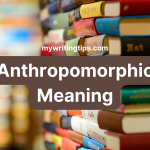What are 100 Examples Of Word Analogy? An analogy is a comparison between two things, typically to explain or clarify a point. It involves identifying a similarity between two different things to help explain a concept, making it more understandable.
Analogies are often used to draw a logical inference between complex ideas and more familiar ones. Here are 100 examples of word analogy to help you grasp the concept.
Table of Contents
100 Examples of Word Analogy
Check out these 100 analogy examples, divided into different categories.
Synonym Analogies
Synonym analogies involve pairs of words that have similar meanings. Here are some examples:
- Happy is to Joyful as Sad is to Mournful.
- Fast is to Quick as Slow is to Leisurely.
- Hard is to Difficult as Easy is to Simple.
- Bright is to Luminous as Dark is to Gloomy.
- Hot is to Scorching as Cold is to Freezing.
- Funny is to Humorous as Scary is to Frightening.
- Rich is to Wealthy as Poor is to Impoverished.
- Strong is to Sturdy as Weak is to Feeble.
- Big is to Large as Small is to Tiny.
- Thin is to Slim as Fat is to Plump.

Antonym Analogies
These analogies focus on words with opposite meanings. Here are some examples:
- Hot is to Cold as Light is to Dark.
- Success is to Failure as Victory is to Defeat.
- Laugh is to Cry as Accept is to Reject.
- Advance is to Retreat as Ascend is to Descend.
- Generous is to Stingy as Brave is to Cowardly.
- Begin is to End as Start is to Stop.
- Happy is to Sad as Optimistic is to Pessimistic.
- Love is to Hate as Peace is to War.
- Young is to Old as Fresh is to Stale.
- Rich is to Poor as Full is to Empty.
Part/Whole Analogies
Part/Whole analogies describe a relationship where one word is a component or segment of the other. These analogies help in understanding how individual parts relate to a larger whole. Here are some examples:
- Wheel is to Car as Finger is to Hand.
- Page is to Book as Leaf is to Tree.
- Key is to Keyboard as Note is to Melody.
- Chapter is to Novel as Scene is to Movie.
- Petal is to Flower as Step is to Staircase.
- Brick is to Wall as Tile is to Floor.
- Button is to Shirt as Lens is to Glasses.
- Rung is to Ladder as Link is to Chain.
- Heart is to Body as CPU is to Computer.
- Chapter is to Book as Episode is to Series.
Thing/Function Analogies
These analogies focus on the relationship between an object and its primary function or use.

- Pen is to Write as Knife is to Cut.
- Camera is to Photograph as Oven is to Bake.
- Clock is to Tell Time as Thermometer is to Measure Temperature.
- Key is to Unlock as Charger is to Charge.
- Mirror is to Reflect as Lamp is to Illuminate.
- Shovel is to Dig as Brush is to Paint.
- Umbrella is to Protect from Rain as Sunglasses are to Shield from the Sun.
- Shoes are to Walk as Gloves are to Protect Hands.
- Bed is to Sleep as Chair is to Sit.
- Book is to Read as TV is to Watch.
Cause/Effect Analogies
To highlight the relationship between an action or event (cause) and its result or consequence (effect), use cause/effect analogies.
- Exercise is to Fitness as Studying is to Knowledge.
- Overeating is to Obesity as Smoking is to Lung Cancer.
- Rain is to Growth as Drought is to Withering.
- Sunlight is to Tanning as Frost is to Freezing.
- Laughter is to Happiness as Crying is to Sadness.
- Training is to Skill as Practice is to Improvement.
- Saving is to Wealth as Spending is to Debt.
- Neglect is to Decay as Care is to Preservation.
- Pollution is to Contamination as Cleaning is to Purification.
- Teaching is to Learning as Guiding is to Following.
Example/Type Analogies
Example/Type analogies illustrate the relationship between a specific instance and the general category or group it belongs to.

Here are some examples:
- Rose is to Flower as Oak is to Tree.
- Sparrow is to Bird as Salmon is to Fish.
- Ferrari is to Car as Rolex is to Watch.
- Cheetah is to Mammal as Eagle is to Bird.
- Apple is to Fruit as Spinach is to Vegetable.
- Piano is to Musical Instrument as Novel is to Literature.
- Python is to Snake as Great White Shark is to Fish.
- Basketball is to Sport as Opera is to Performing Arts.
- Everest is to Mountain as the Pacific is to Ocean.
- Monday is to Weekday as January is to Month.
Step/Process Analogies
Step/Process analogies highlight how individual actions or stages contribute to the completion of a larger procedure or task.
- Sowing is to Farming as Brainstorming is to Planning.
- Mixing Ingredients is to Baking as Researching is to Writing a Paper.
- Taking Off is to Flying as Starting the Engine is to Driving.
- Laying Foundations is to Building as Outlining is to Writing.
- Warming Up is to Exercising as Preparing Ingredients is to Cooking.
- Sketching is to Painting as Drafting is to Writing.
- Booting Up is to Computing as Tuning is to Playing an Instrument.
- Enrolling in College is to Education as Hiring Employees is to Starting a Business.
- Saving Money is to Investing as Learning Chords is to Playing Guitar.
- Brainstorming is to Innovation as Researching is to Scientific Discovery.
Problem/Solution Analogies
These analogies are useful for understanding how different problems are approached and solved. Here are some examples:

- Lock is to Key as Illness is to Medicine.
- Hunger is to Food as Thirst is to Water.
- Puzzle is to Solution as Question is to Answer.
- Fire is to Extinguisher as Flood is to Sandbags.
- Darkness is to Light as Silence is to Sound.
- Flat Tire is to Spare Tire as Power Outage is to Generator.
- Infection is to Antibiotics as Drought is to Irrigation.
- Stain is to Detergent as Wrinkle is to Iron.
- Debt is to Payment as Ignorance is to Education.
- Lost is to Map as Confused is to Explanation.
Noun/Adjective Analogies
Noun/Adjective analogies show how nouns are commonly associated with particular adjectives, illustrating the qualities or attributes of various objects, places, or phenomena.
- Snow is to Cold as Fire is to Hot.
- Sugar is to Sweet as Lemon is to Sour.
- Sun is to Bright as Night is to Dark.
- Feather is to Light as Rock is to Heavy.
- Library is to Quiet as Concert is to Loud.
- Ice is to Slippery as Sandpaper is to Rough.
- Rose is to Fragrant as Skunk is to Pungent.
- Mirror is to Reflective as Sponge is to Absorbent.
- Wool is to Soft as Steel is to Hard.
- Desert is to Arid as Rainforest is to Humid.
Increasing or Decreasing Intensity Analogies
These analogies illustrate the progression or regression of various states, indicating how they can intensify or weaken under different circumstances.
- Whisper is to Shout as Breeze is to Hurricane.
- Flicker is to Blaze as Trickle is to Flood.
- Annoyance is to Rage as Discomfort is to Agony.
- Chilly is to Freezing as Warm is to Scorching.
- Murmur is to Scream as Hum is to Roar.
- Drizzle is to Downpour as Spark is to Inferno.
- Concern is to Panic as Unease is to Terror.
- Dim is to Bright as Quiet is to Loud.
- Nudge is to Push as Tap is to Slam.
- Hesitate is to Refuse as Ponder is to Reject.
Learn more: Metonymy vs Synecdoche
Wrapping It Up!
We hope these 100 examples of word analogy gave you somewhat of a peak diversity and versatility of this linguistic tool. Whether used in education, literature, or everyday conversation, analogies are invaluable in making complex ideas more accessible and relatable.


